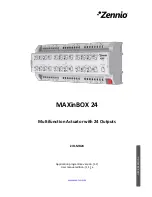
Hardware Components
UG0048 User Guide Revision 5.1
7
voltage to the 1.5 V core. Three of the twelve pins are ground pins, which will provide more than sufficient
current return capability for future Microsemi SoC Products Group daughter cards that will work with this
board.
3.4.2
Power Supplies and Chaining Boards Together
When joining multiple ProASIC3/E Starter Kit boards together through the chain programming
connection, J2 connector is used to connect the J1 connector of the next board in the chain by attaching
a standard 0.100-inch pitch 10-pin programming cable. The length of the cable must be kept as short as
possible, because multiple boards connected form a JTAG chain of ProASIC3/E devices can provide
much greater noise pick-up and may degrade the TCK clock for devices remote from the FlashPro4
programmer. A rotary switch SW10 is provided on the board to set the VJTAG supply. Select the VJTAG
supply between 1.5 V, 1.8 V, 2.5 V, and 3.3 V using SW10. Set VJTAG at an absolute minimum of 1.8 V
to help with signal integrity when chaining boards together. Higher voltages can give better noise and
impedance mismatch immunity.
Disconnect the jumper at JP10 on all boards. This jumper can be used to provide VJTAG to a
downstream board or to some element in the design that you wish to supply with the VJTAG voltage used
by the ProASIC3/E component. The shunt that is normally in this location can be safely stored across
pins 11 and 12, or 9 and 10 of the J12 daughter card power supply connector. For particularly long
chains, the value of TCK used during programming must be reduced.
During the development, various revisions of the ProASIC3/E Starter Kit board are produced. This
documentation contains additional text that documents some of these earlier versions, as well as the
newest version of the board. The latest version of the board A3PE-STARTER-KIT-2 REV B does not
have OLED display. A3PE-STARTER-KIT-2 REV A version is same as A3PE-PROTO-KIT except the
LCD display is replaced with an OLED display and all the components are RoHS compliant. Schematics
for Rev3 and Rev2 boards are the same when viewed as PDF files, but there is a short in the board
layers on the Rev2 that has been corrected for Rev3. The rare Rev1 prototype boards had different
schematics and are not discussed in this document.
3.4.2.1
Procedure for Rev A Boards
To determine if the board is a Starter Kit Rev A board: A Rev A board is recognized by examining the
front of the board and looking for the part number just beneath the large Microsemi corporate logo on the
board top silk-screen. The part number is A3PE-STARTER-KIT-2 followed by REV A.
To chain Starter Kit Rev A boards together: All boards from the board nearest the FlashPro4 programmer
must have the shunt that is placed by default on pins 3 and 4 of the J5 header moved to connect pins 1
and 2. On the board and schematic CHAIN (pins 1 and 2) and LAST DEVICE (DEFAULT) (pins 3 and 4)
are labeled clearly. Only the last board in the chain must have the shunt remaining across pins 3 and 4 of
the J5 connector.
Note:
If there is only one board in the chain then it, by definition, is the last board and should have the shunt at
J5 connecting pins 3 and 4. This is why this position is labeled as the DEFAULT position for a typical
customer with a single starter kit board.
3.4.2.2
Procedure for Rev3 Boards
To determine if the board is a Rev3 board: A Rev3 board is recognized by examining the front of the
board and looking for the part number just beneath the large Microsemi SoC Products Group corporate
logo on the board top silk-screen. The part number is A3PE-A3P-EVAL-BRD1 followed by REV3.
To chain Rev3 boards together
: Treat it as Starter Kit Rev A board in the previous section.
3.4.2.3
Procedure for Rev2 Boards (With and Without Rework)
To determine if the board is a Rev2 board: A Rev2 board is indicated by a red LED in the upper right
corner of the board and a part number underneath the Microsemi SoC Products Group corporate logo on
the board top silk-screen. The part number is A3PE-A3P-EVAL-BRD1. No additional text is followed with
the board number. If the board is reworked to force it to become equivalent to a Rev3 board, it contains a
green wire on the top side of the board. If it does not contain green wire, it is Rev2.
Содержание ProASIC3/E Proto Kit
Страница 1: ...UG0048 User Guide ProASIC3 E Starter Kit ...














































